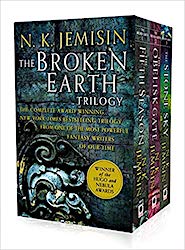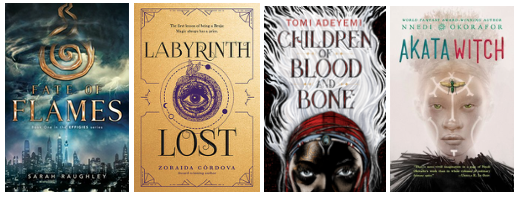Decolonizing My List of YA Speculative Fiction
A MiddleWeb Blog
 Talk about transparent learning. I’m ashamed to admit that it took me too long to see that the five books of speculative fiction I recommended in my last post were all by white women authors.
Talk about transparent learning. I’m ashamed to admit that it took me too long to see that the five books of speculative fiction I recommended in my last post were all by white women authors.
The irony is that I am personally reading lots of speculative fiction by authors of color. So why, then, didn’t they make my list for the post?
There are a few legit, but flimsy, reasons that spring to mind. One is that I was automatically reaching for books and authors that would be “known” to teachers already, in an attempt to have them view those books and authors in a different light.
Another is that most of my diverse reading is of the adult variety at the moment, and – middle school teachers will empathize with this challenge – sometimes a great book otherwise appropriate for middle school can have explicit descriptions of sex or violence that require treading carefully when recommending them.

But the most important reason I didn’t include a diversity of authors in my post intended to champion diversity is that there is a very basic level of re-teaching and un-learning for myself that I am still doing.
I am a product of teacher education and experience of the late 1990’s and early 2000’s, where diversity in kid lit was regarded as a beautiful thing in its own siloed space, but not – as it should be – in the air we breathe and water we drink. And so when I pull books from my base well of knowledge, I should be on my guard that the books by white authors may, sadly, rise to the top.
I am still the teacher in the bubble. And I need to be reminded, over and over again, that my privileged circumstances, training, and habits of mind require me to back up my good intentions with hard action. There are no short cuts.
So I’m going to put something into accountable practice for myself. For every novel I read by a white author, the next novel I read – not “the next one I plan to read,” “the next one I purchase,” or “the next one I read about,” but the next one I read – will be one by a YA (speculative) author of color. I’ll review every one I read here on the blog. And I should probably do this for, you know, the rest of my life, so no singleton New Year’s resolution here. It’s not a diet – it’s a lifestyle change, people.
Here are the first four books on my list.

(These last three are completely new to me and I’m excited to dive in.)
The Fate of Flames, Sara Raughley.
The Akata Witch, Nnedi Okorafor.
Labyrinth Lost, Zoraida Cordova.
Know of others you love or are intrigued about? Put them in the comments and I’ll read them. That’s a promise.



































Dina-
Thank you for such an honest post! I too can relate to your desire to broaden your personal reading as well as the offerings for your students. In a time of broadening our horizons, we need to be better about being transparent as well as diversifying our options for our students. I have found a resource for books in the event that you need more for your list at: https://coloursofus.com/multicultural-summer-reading-middle-school/.
It can help with more ideas if you get stuck.
Again, thanks for being so transparent!!!
Super kind and supportive of you, Misty. I will definitely take a deep dive into the link you gave and report back! ~ Dina